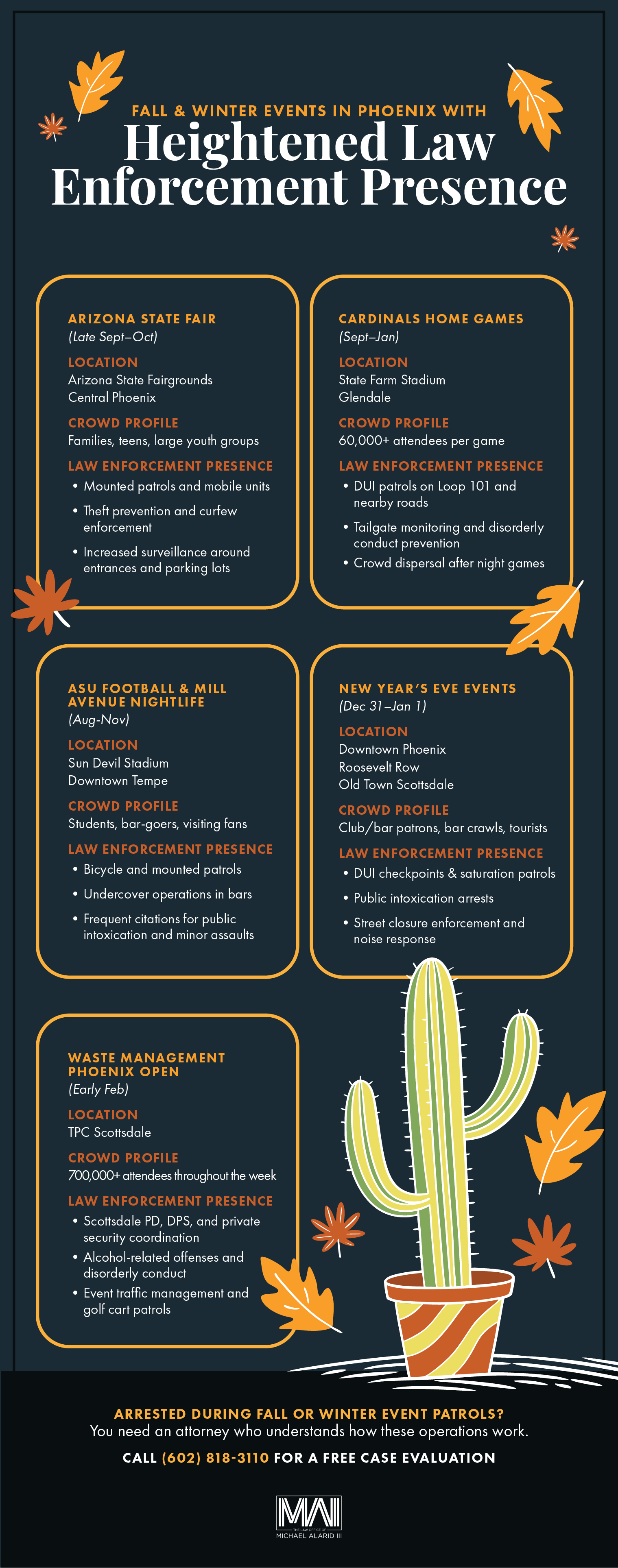Do Arrests Spike in Phoenix When the Temperatures Drop?


The studies that have looked into the seasonality of crime often find a positive correlation between crime and temperature or favorable weather conditions.
In places with cold winters, that “comfortable window” tends to fall in summer. But in a hot-desert city like Phoenix, that window may shift into fall and winter, when overnight temperatures become livable again.
The “routine activities theory” is essentially that crime depends on the intersection of a person who wants to commit a crime, a suitable target, and the absence of the property owner. In other words, more victims are spending time outdoors, going to events, and generally being away from their home or vehicle, meaning less natural surveillance of their property.
Other theories suggest longer nights during fall and winter lead to a higher number of property crimes that are aided by darkness.
The evidence is often mixed and highly situational based on the metro area being studied. Focusing solely on weather means not accounting for the many other variables that influence crime rates.
How Arizona Is Different From Colder States
Studies and articles that do attempt to find a correlation between temperature and crime aren’t usually focused in Arizona. It makes sense that murder rates were higher on days above 85 degrees Fahrenheit in cities like Chicago and Milwaukee considering how the brutal cold of winter makes going outside and committing crimes a much less inviting proposition. The opposite is true in Arizona, where the occasional analysis of crime and weather often finds the nicer winter months have a slightly higher incidence of crimes.
According to Phoenix police’s reporting data, the end of the first quarter (January, February, and March) consistently has the highest rates of property crimes, but that same consistent trend isn’t reflected in violent crimes.
Differences Between Violent and Nonviolent Offenses
Phoenix’s Monthly Count of Actual Offenses Known to Police
In 2022, property crimes were at their highest, 13,183 actual offenses, at the end of the first quarter, and they were at their lowest, 11,065 actual offenses, at the end of the third quarter (July, August, and September).
In 2023, they were also at their highest, 10,503 actual offenses, at the end of the first quarter and their lowest, 10,119 actual offenses, at the end of the second quarter (April, May, and June).
In 2024, they were at their highest at the end of the first quarter with 10,363 actual offenses and their lowest at the end of the third quarter with 9,419 actual offenses.
There is no consistent peak in total violent crimes. In 2022, the peak was summer. In 2023, the peak was spring. In 2024, the peak was summer again. But in all the years, the difference in violent crime between seasons is relatively small.
Why Is There a More Consistent Difference in Property Crime?
- Opportunity vs. motivation. Property crimes depend more on access and visibility. Cooler weather brings more people outdoors and results in more homes and vehicles being left unattended. Longer nights mean more cover of darkness.
- Social proximity. Violent crime is more situational and tied to personal disputes, which aren’t as affected by climate shifts. It doesn’t matter what the weather is outside if the alleged perpetrator and victim share the same air conditioned space.
- Data sensitivity. Property crime volumes are larger, so small seasonal changes appear as visible trends, whereas violent crime numbers are smaller and more erratic.
The Limits of Weather-Based Crime Analysis
Weather patterns explain only part of the picture. Other factors like enforcement strategies, reporting cycles, and administrative processes can heavily influence apparent crime trends.
For example, Phoenix PD often deploys additional patrols during event-heavy periods and holiday weekends. Those operations can elevate arrest totals without any actual increase in criminal activity. Just because more people are being arrested doesn’t mean there are more people committing crimes; it only means more people are being caught.
How a law enforcement agency performs end-of-year data consolidation or monthly and quarterly reporting may also shift when certain offenses appear in public records.
And apart from actual policing practices there are also tourism cycles and local economic factors, which both may overshadow temperature effects entirely.
There are many factors influencing crime, crime reporting, and arrest rates, so any correlation between cooler temperatures and higher arrest counts should be viewed as suggestive rather than causal.
Regardless of When You Were Arrested, an Arizona Board-Certified Criminal Defense Specialist Can Help
Michael Alarid III is a Board-Certified Criminal Law Specialist who defends Phoenix clients in all types of criminal matters, from DUI and property crimes to assault and sex crimes.
Call our office at (602) 818-3110 for a free case evaluation.



